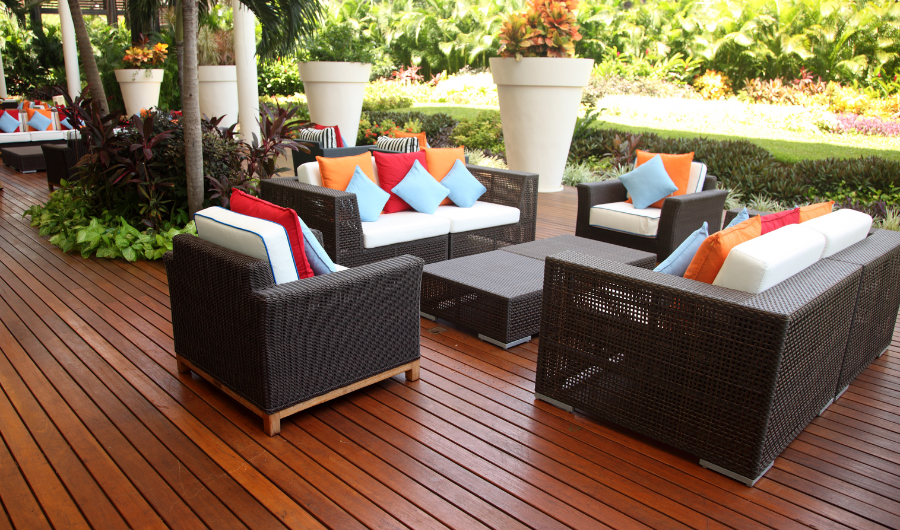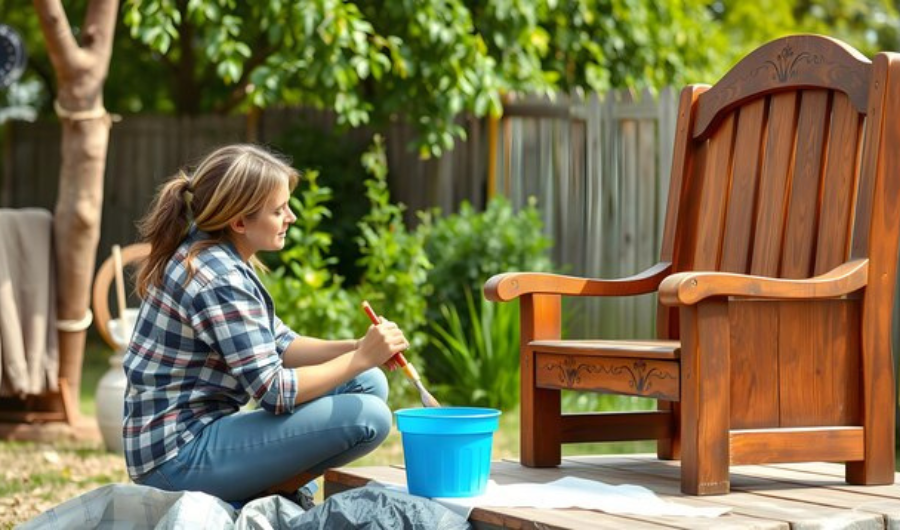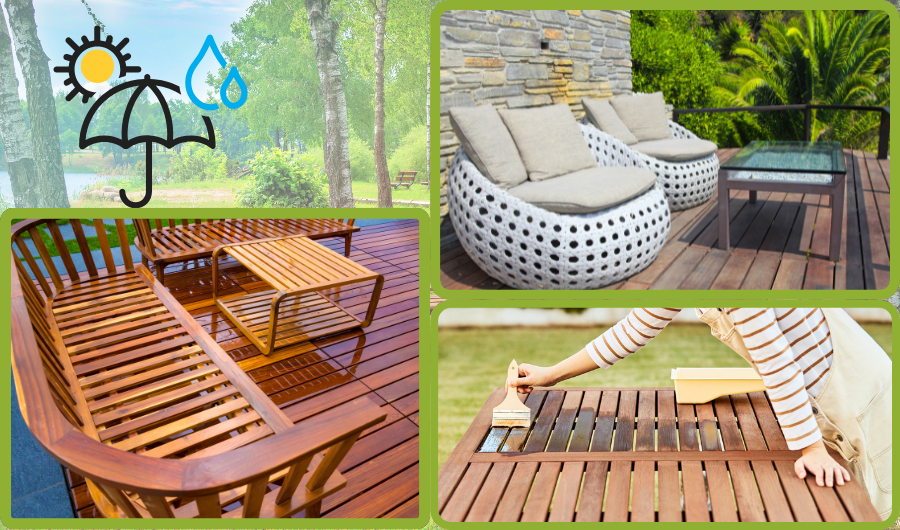Wooden furniture adds warmth and elegance to outdoor spaces. However, exposure to the elements rain, sun, and humidity can lead to warping, cracking, fading, and rot. To preserve your outdoor wood furniture’s beauty and durability, it’s essential to weatherproof it properly. Learning how to weatherproof wood furniture for outdoors is essential to maintaining its beauty and endurance. This comprehensive guide will walk you through the steps to protect your furniture, ensuring it withstands the test of time.
Understanding Wood and Weathering
Wood is a natural material that reacts to environmental changes. Moisture causes it to expand, while heat leads to contraction. Over time, these fluctuations can result in:

- Warping: Uneven moisture absorption causes the wood to bend or twist.
- Cracking: Temperature changes can cause the wood to expand and shrink, resulting in fractures.
- Fading: Wood’s natural color may fade with prolonged exposure to sunshine.
- Rotting: Fungi can grow more readily in damp environments, which can result in wood rot.
Let’s now investigate practical solutions to weather wooden furniture and address these problems.
Selecting the Right Wood for Outdoor Use
Not all woods are equally suited for outdoor furniture. Some species naturally resist decay and weathering better than others. When choosing wood for outdoor furniture, consider the following:
- Teak: High in natural oils, teak resists water and pests.
- Cedar: Lightweight and aromatic, cedar repels insects and resists moisture.
- Redwood: Dense and durable, redwood withstands the elements well.
- Ipe: Extremely hard and dense, ipe offers excellent weather resistance.
Opting for these types of wood can reduce the amount of maintenance required over time.
Preparing Your Furniture for Weatherproofing
For any weatherproofing technique to be successful, planning is key. To make sure the wood you use is prepared for protection, take these steps:
- Clean the Surface: Use a wood cleanser or light detergent to remove any dust, dirt, and previous finishes. Deep cleaning might benefit from the use of a pressure washer.
- Sand the Surface: Use sandpaper to round out any rough edges or flaws. This enhances the look and facilitates greater adhesion of the weatherproofing agents.
- Repair Damage: Use wood filler to seal any holes or cracks and make the required repairs to guarantee a smooth surface.
Taking the time to prepare your furniture properly will enhance the effectiveness of the weatherproofing process.
Choosing the Right Weatherproofing Products
After preparing your wood furniture, it’s time to select the appropriate weatherproofing material. There are several choices available, each with special advantages. Typical options consist of:
- Sealants and Stains: These treatments offer a protective coating on top of improving the wood’s appearance. While stains provide color and offer UV protection, sealants provide a barrier against moisture.
- Waterproofing Oils: By penetrating the wood from the inside out, waterproofing oils like tung or linseed oil nourish and preserve it. These oils work well to bring out the wood’s inherent beauty.
- Polyurethanes and Varnishes: These coatings provide the wood a tough, shielding layer. They work well, but with time, they may become more more susceptible to peeling and breaking.
Application Techniques
Applying weatherproofing products correctly is vital for maximum protection. Here’s how:
- Follow Manufacturer Instructions: Each product has specific guidelines for application and drying times.
- Use Appropriate Tools: Brushes, rollers, or sprayers can be used depending on the product and furniture design.
- Apply in Suitable Conditions: Choose a dry day with moderate temperatures. Avoid direct sunlight, which can cause rapid drying and uneven finishes.
- Multiple Coats: Apply several thin coats, allowing each to dry thoroughly before the next. This builds up a robust protective layer.
Proper application ensures the longevity and effectiveness of the weatherproofing treatment.
Regular Maintenance
For extended protection,weatherproofing requires ongoing maintenance rather than a one-time effort. Adhere to these guidelines:
- Clean Regularly: Use a mild soap and water solution to clean frequently to get rid of dirt, pollen, and other debris.
- Inspect for Damage: Ensure that your furniture is regularly inspected for indications of wear, damage, or reapplication needs.
- Reapply as Needed: Depending on the product, you might need to do a reapplication every two or three years. To get the greatest results, heed the product instructions.
Consistent upkeep extends the life and appearance of your outdoor wood furniture.
Weatherproofing Indoor Furniture for Outdoor Use

Transforming indoor furniture for outdoor use requires additional steps:
- Assess Suitability: Ensure the furniture is sturdy and made of solid wood, not particleboard.
- Thorough Cleaning and Sanding: Remove any existing finishes and smooth the surface.
- Apply Exterior-Grade Sealants: Use products designed for outdoor conditions, such as spar urethane or marine varnish.
- Protect Upholstery: Replace indoor fabrics with weather-resistant options or use removable covers.
With proper treatment, indoor furniture can withstand outdoor environments.
Best Paints for Outdoor Wood Furniture
Choosing the best paint for outdoor furniture enhances both protection and aesthetics:
- Acrylic Latex Paint: Durable and flexible, it resists cracking and fading.
- Oil-Based Paint: Provides a hard, long-lasting finish but requires longer drying times.
- Milk Paint with Outdoor Additive: Offers a natural look with added weather resistance.
Always pair paint with a suitable primer and topcoat for maximum durability.
Outdoor Furniture Sealants and Sealers
Sealants and sealers are crucial for protecting wood from moisture and UV damage:
- Seal-Once Nano+Poly Premium Wood Sealer: Low in VOCs, it provides a durable, waterproof barrier.
- Total Wood Armor: Plant-based and eco-friendly, offering long-lasting protection.
- Thompson’s WaterSeal: Widely available and easy to apply, suitable for various wood types
Select a product that matches your wood type and environmental conditions.
Final Words
It takes time and money to properly weatherproof your outdoor wood furniture. Still, the advantages of a stunning and durable outdoor area make the work worthwhile. Wooden furniture may add elegance to your outdoor space for many years to come if you know a few things about weathering and wood, prepare your furniture properly, select the best weatherproofing materials, and give it regular maintenance.
FAQs
Q1: How often should I reapply weatherproofing treatments?
A1: Typically, every 1-2 years, depending on exposure to elements and product used.
Q2: Can I use indoor furniture outdoors if I weatherproof it?
A2: Yes, but ensure it’s solid wood and properly sealed with outdoor-grade products.
Q3: What’s the best oil for waterproofing wood?
A3: Tung oil and linseed oil are excellent choices for penetrating and protecting wood.
Q4: Do I need to sand between coats of sealant or paint?
A4: Light sanding between coats ensures better adhesion and a smoother finish.
Q5: Is it necessary to use a primer before painting outdoor furniture?
A5: Yes, a primer enhances paint adhesion and provides an additional layer of protection.

